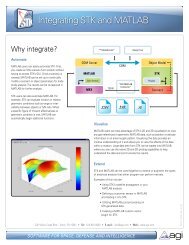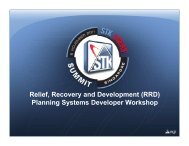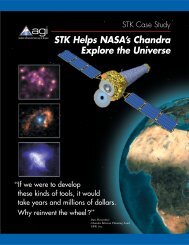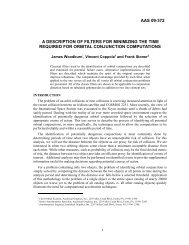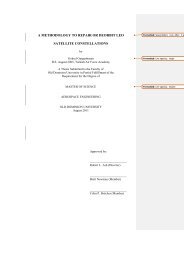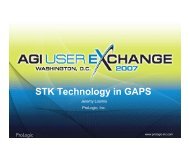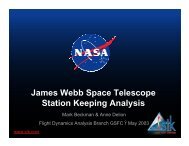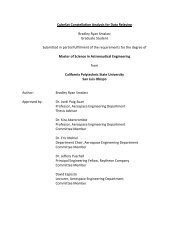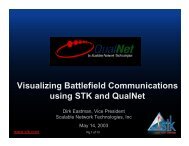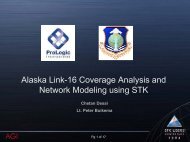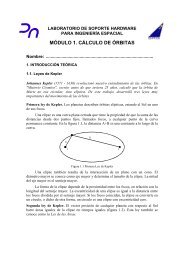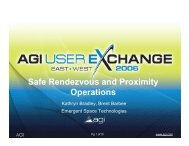nmd_brochure_w.qxd (Page 1) - AGI
nmd_brochure_w.qxd (Page 1) - AGI
nmd_brochure_w.qxd (Page 1) - AGI
Create successful ePaper yourself
Turn your PDF publications into a flip-book with our unique Google optimized e-Paper software.
Analytical Graphics, Inc.www.stk.comMissile DefenseAnalysis and Visualization SolutionsThousands of aerospace professionals have trusted Satellite Tool Kit® (STK) todesign, analyze, and perform satellite missions. The independently validated andverified STK software suite is also used in nearly every major missile defense programby leading U.S. commercial contractors and government agencies.With integrated land, sea, air, and space elements, Analytical Graphics, Inc.’s (<strong>AGI</strong>) STKsoftware is ideal for systems engineering tasks throughout all phases of a complexmissile defense program—from concept and design, through testing, deployment, andoperations. STK provides accurate, detailed solutions for specific defense programneeds such as:◗ missile system design◗ threat analysis◗ intercept analysis◗ radar system design◗ operations analysis◗ space segment modelingSTK solutions address test and evaluation (T&E) requirements by supporting missionplanning, real-time operations, post-flight analysis, training, and customer communications.The versatility and flexibility of STK allows users to quickly and easily integrateit with existing systems engineering software to realize significant efficiency gains.
Missile Defense ProgramsUsing STK ComponentsNMD – GBI/EKV, T&E, Modeling & Simulation,UEWR, XBRTMD – Navy Area Defense, Navy Theater Wide,THAAD, BMC3Airborne LaserGBRP RadarPAC3SBIRS HighSBIRS LowSpace Based LaserVarious Cruise and Tactical Missile ProgramsCustomers Using STK in MissileDefense-Related ActivitiesAdroit Systems, Inc.Aegis Research CorporationANSERThe Boeing CompanyBooz-Allen & HamiltonCOLSA CorporationCSCDynetics, Inc.Emergent Information Technologies, Inc.Institute for Defense Analysis (IDA)ITT IndustriesJHU/Applied Physics LaboratoryJoint National Test Facility (JNTF)Lawrence Livermore National LaboratoryLockheed Martin Corp.Logicon Geodynamics Inc.Logicon TASCMadison Research CorporationMillennium Science & Engineering, Inc.MIT Lincoln LaboratoryMITRE CorporationNIMANaval Research LaboratoryPOETPacific Missile Range Facility (PMRF)Photon Research Associates, Inc. (PRA)Raytheon CompanySAICSandia National LaboratoriesSchafer CorporationSimulyze Inc.Sparta, Inc.Spectrum Astro, Inc.Teledyne Brown EngineeringTRWUSAF-AFITUSAF-Hanscom AFBUSAF-Kirtland AFBUSAF-Wright Patterson AFBU.S. Army-SMDCU.S. Army-White Sands Missile RangeU.S. Naval Surface Warfare CenterU.S. Naval War CollegeU.S. Navy TENCAPXontech, Inc.The commercial off-the-shelf (COTS) STK suite has benefited from more than 12 years of continuous product development. This evolutionallows <strong>AGI</strong> to bring to market validated, verified, technically accurate software that has proven successful through extensive use ina variety of aerospace and defense programs. The missile defense community collectively benefits from STK by not having to “reinvent thewheel.” Implementing COTS products into defense systems allows users to immediately realize significant cost and time savings.
System Design and Engineering SolutionsEasy integration of STK software into existing system engineering processes is possible through standard methodssuch as the STK/MATLAB Interface, TCP/IP interface, and ASCII flat files. STK can also be used as a dynamicgeometry and parameter engine client to other simulations and analyses.Analyze multi-object threat complex with RV’s,decoys, and other penetration aids, along with theorientation of the delivery system with respect toground radars, EKV sensors, and satellite sensors.HERITAGESE & ISYSTEMSINTEGRATION OF STK INTOEXISTING SYSTEMSSTK/CONNECTSTKSTK/VOMultiple vectors and coordinate systems providevisual cues in a 3-D environment enabling a quickunderstanding of complex missile system attitudeand direction relationships.Missile System Design◗ Simulate all phases of missile flight—launch, boost,PBV staging, mid-course, and reentry◗ Model DoD classified missiles◗ Interface to existing 6DOF trajectory generators◗ Perform various parametric analyses and solvemulti-constraint problems◗ Analyze dynamically changing communicationslink parameters◗ Visualize flight profiles and inter-geometric dynamicrelationships (vector histories, lighting conditions,viewing conditions) in detailed 3-DThreat Analysis◗ Use STK with STAMP and/or DICE to generate andanalyze different threat models◗ Characterize various threats against fixed radar assets◗ Visualize various threat object deployment distributions◗ Analyze the geometric history of threat complex withrespect to sensor fields-of-view (FOV)Launch-to-Intercept Analysis◗ Compare interceptor defense performance againstballistic missiles, aircraft, and satellites◗ Incorporate intercepts into simulations to analyze dynamicgeometry relationships, radar performance, radar systemdesign, and space surveillance system performance◗ Evaluate the interaction of the USSPACECOM catalog ofsatellites and debris with radar and sensor fields-of-viewRadar System Design◗ Model radar systems including monostatic, bi-static,search/track, fixed PRF or continuous wave, and SAR◗ Assign aspect angle and frequency dependent radarcross section (RCS) files to missile elements◗ Employ state-of-the-art antenna propagation and radiofrequency (RF) environment models◗ Analyze detection performance using calculated signalto-noiseratio (SNR) and probability of detectionOperations Analysis◗ Analyze effectiveness of air defense radars to generatedthreat configurations◗ Determine flight trajectories for visibility characteristics◗ Iterate across launch and intercept trade space◗ Analyze relations between various flight profiles/threatconfigurations and probability of detectionSpace Segment Modeling◗ Perform SBIRS High & Low visibility and coverage analysisof various constellation configurations against various missilethreat profiles and distributions◗ Design and model sensors through various sensorconfigurations, parametric and constraint analyses
Test and Evaluation SolutionsSTK software provides users with a complete mission design, planning, training, testing, and post-flight analysisenvironment. Flexible and powerful, STK is quickly integrated into existing tools and systems through theSTK/Connect TCP/IP interface.Mission planningDesign missile flight trajectories across multiplemission constraintsDisplay complete flight trajectories including staging,PBV maneuvers, RV deployment, and error ellipsoidsIntegrate STK with existing trajectory models to use asa parametric and constraint analysis toolDynamic geometry and coverage parametersCommunication link parametersRadar performance parametersPerform range safety analysisAnalyze launch windowsReal-time operationsVisualize real-time missile or satellite telemetry in 3-Dto display position, attitude, and key trigger eventsPredict real-time AOS/LOS time and pointingDetermine range-safety based on real-time visualization andradar measurementsDisplay EKV sensor field of view, and real-timeradar/sensor pointingStream STK output for network or Web broadcastingPost-flight analysis:Review predicted and actual flight trajectories, attitude history,and sensor history immediately after flightAnalyze various geometry aspects of flight testVector histories with respect to various mission objectsincluding EKV, PBV, RV, fly-away package, and a varietyof other missile elements of threat and intercept platformsRange deltas and range-rate historiesAttitude dynamics analysisAnalyze system performance (radar, comm links)Perform anomaly resolution analysisDetailed custom reporting and graphingCustomer/Program Communications:Demonstrate high-level concepts by generating accurate,3-D program support materials including animations,graphics, and videosTrainingUtilize STK for detailed pre-mission rehearsalsEnhance understanding of critical mission eventsIntegrate STK analysis and visualization capabilitiesinto existing training regimensSTK software models realistic deployments ofthreat complexes including various RV's andpenetration aids. It provides the ideal modelingenvironment to analyze the deployment againstradar systems and detection sensors.STK provides a cost effective means of creatingpre-mission, real-time, and post-mission 3-Dvisualization of test events for analysts,managers, VIP's, and customers.COTS REAL-TIME VISUALIZATIONFOR CONTROL CENTERSTELEMETRYSYSTEMSTK/VO &STK/CONNECT
<strong>AGI</strong> Support ServicesTechnical SupportTechnical support engineers are available to <strong>AGI</strong>customers weekdays from 8 a.m. to 8 p.m. ET viaphone, fax, or e-mail.Training<strong>AGI</strong> offers customized, on-site training services toteach users how the STK software suite can beutilized for specific missile defense program needs.Consulting<strong>AGI</strong> offers value-added engineering services tosupport customers’ specific requirements such asimplementation of integrated STK solutions,creation of custom interfaces to STK, and enablingof real-time telemetry systems.Create custom sensors to analyze complicatedfields-of-view, and model geometric constraints ofradar and comm systems.<strong>AGI</strong> Business Partners in Missile DefenseSAIC/Applied Technology Group (SAIC/ATG)<strong>AGI</strong> has partnered with Huntsville, AL-based SAIC/ATG to develop the STK/MissileModeling Tools software. Through its Center for Integrated Space Modeling, Analysis andTraining (CISMAT), SAIC/ATG also provides STK proficiency training; softwareintegration services; STAMP upgrades and threat model definitions; scenario and modeldevelopment; and various programming and scripting services.The MathWorks, Inc.As a MathWorks Connections partner, <strong>AGI</strong> has developed the STK/MATLAB Interface.This two-way communication bridge integrates the high-fidelity astrodynamic, geometric,and visualization capabilities of STK with the world-renowned computational powerof MATLAB.Photon Research Associates (PRA)<strong>AGI</strong> has teamed with PRA to produce the STK/Radar Advanced Environment module.This software extends the capabilities of STK/Radar by introducing advanced radaranalysis capabilities such as global 4 km resolution clutter computations and the ability tosimulate monostatic pulse Doppler radars.Surface Optics Corp. (SOC)Business partner SOC offers RadBase, a commercially available radar database generationsystem. RadBase complements STK by creating aspect- and frequency-dependent radarcross sections (RCS) of STK models for use with STK/Radar.Xontech, Inc.<strong>AGI</strong> is a member of Xontech's BMDO Support Services Program (BSSP) team, whichprovides COTS software capability for many aspects of BMDO program system’s engineering;test and evaluation; and program communications requirements.STK
Software SuiteThe Satellite Tool Kit software suite consists of more than 20 specialized add-on modules that extendthe functionality of STK. Brief overviews of key STK modules for use in missile defense programapplications are provided below. For additional specifications on these and other STK products, please“Explore STK” on the STK CD-ROM, call <strong>AGI</strong> at 800.220.4785, e-mail info@stk.com, or visit www.stk.com.STK/PRO. This core analysis module of the STK software suiteprovides a dynamic geometry engine; inter-visibility calculations;trajectory generation and integration; attitude and sensor analysis;multiple map projections; constraint analysis; terrain analysis;inter-object geometry; and geographic reporting and graphing withaccess to more than 2,000 data-provider parameters fromSTK/PRO and other STK software modules.STK/Visualization Option (STK/VO) and STK/AdvancedVisualization Option (STK/Advanced VO). STK/VO andSTK/Advanced VO allow terrestrial, airborne, and space-basedsystems to be visualized in 3-D with time-varying aspects of theirposition and attitude. Inter-object relationships and dynamicconditions are displayed with visual cues in the form of frame-ofreferencevectors, line-of-sight vectors, and celestial referenceobjects/frames/grids. Hundreds of land, sea, air, and spaceobjects are portrayed via detailed 3-D models with articulated,time-varying properties.STK/Conjunction Analysis Tools (STK/CAT). STK/CATprovides proximity analysis to determine potential collisions, laserfiring opportunities, and launch windows.STK/Comm. This STK module provides dynamic link performanceand RF interference analysis for communication networksusing the complete spectrum of link analysis parameters.STK/Coverage. STK/Coverage executes satellite coverageanalysis of definable geographic regions over time. It also allowsusers to evaluate a variety of figures of merit (including timeaverage gap, revisit time, response time, coverage time, GPS/DOPcalculations) to optimize system design and mission planning.STK/VO Earth Imagery. These data sets provide a variety offull-color, global, 1 km resolution imagery generated fromcomposite cloud-free satellite imagery is available for enhancedvisualization within STK/VO's 3-D environment.Analytical Graphics, Inc.STK/Missile Modeling Tools (STK/MMT). STK/MMT iscomprised of STK/Missile Flight Tool (STK/MFT), STK/MissileConversion Tool (STK/MCT), and STK/Interceptor Flight Tool(STK/IFT). These software modules model prototype missiles,official classified missiles, and interceptor flyouts. The high-fidelitymissile propagator within this software simulates all major eventsof missile flight, including boost, staging, post-boost maneuver,deployment, and re-entry. These missile trajectories are based onthe government-certified algorithms used by STAMP (StrategicTheater and Attack Missile Program).STK/Radar and STK/Radar Advanced Environment.These STK modules analyze both monostatic and bi-static radarsystems, and support operations in Synthetic Aperture Radar(SAR) and/or Search/Track modes. Using STK/Radar enablesoperations analysis of radar systems for optimal design andplacement. STK/Radar Advanced Environment extends thecapabilities of STK/Radar by modeling pulse Doppler radars andincorporating characteristics such as clutter, noise, system parameters,radar cross sections, and antenna types.STK/Connect. STK/Connect enables STK to operate in a clientservermode via TCP/IP or UNIX socket interface. This STKmodule offers users real-time analysis and visualization includingexternal data input, integration with other software applications,and automated testing.STK/Geographic Information System (STK/GIS). STK/GISintegrates industry-standard GIS shapefiles with STK viaimport/export functionality. System designs are enhanced throughthe ability to analyze sensor footprints, sensor swaths, area targets,and antenna gain contours with a wide variety of associatedgeographic information.STK/WebCast. This module allows near real-time streaming ofSTK 2-D and STK/VO 3-D output to remote clients across localintranets/networks or the Internet. It is typically used in missioncontrol centers and operations facilities.STK provides high fidelity satellite modeling to design space surveillanceconstellations and analyze threat object histories with respect to sensor boresights.©2001 Analytical Graphics, Inc.All copyrights, trademarks, and registered trademarks are the property of their respective owners. Analytical Graphics®, Analytical Graphics, Inc., Satellite Tool Kit® (STK), STK/PRO®, STK/VO®,STK/Advanced VO, STK/Astrogator, STK/CAT, STK/Chains, STK/Comm, STK/Connect, STK/Coverage, STK/DIS®, STK/GIS®, STK/High Res Maps, STK/PL®, STK/PODS, STK/Radar,STK/Radar Advanced Environment, STK/Server®, STK/Space Environment, STK/Terrain, STK/VO Earth Imagery®, and STK/WebCast are trademarks of Analytical Graphics, Inc. Face of the Earthis a trademark of ARC Science Simulations, Inc. MATLAB® is a registered trademark of The MathWorks, Inc.Analytical Graphics, Inc.Software Solutions for the Aerospace Industryinfo@stk.comwww.stk.com



